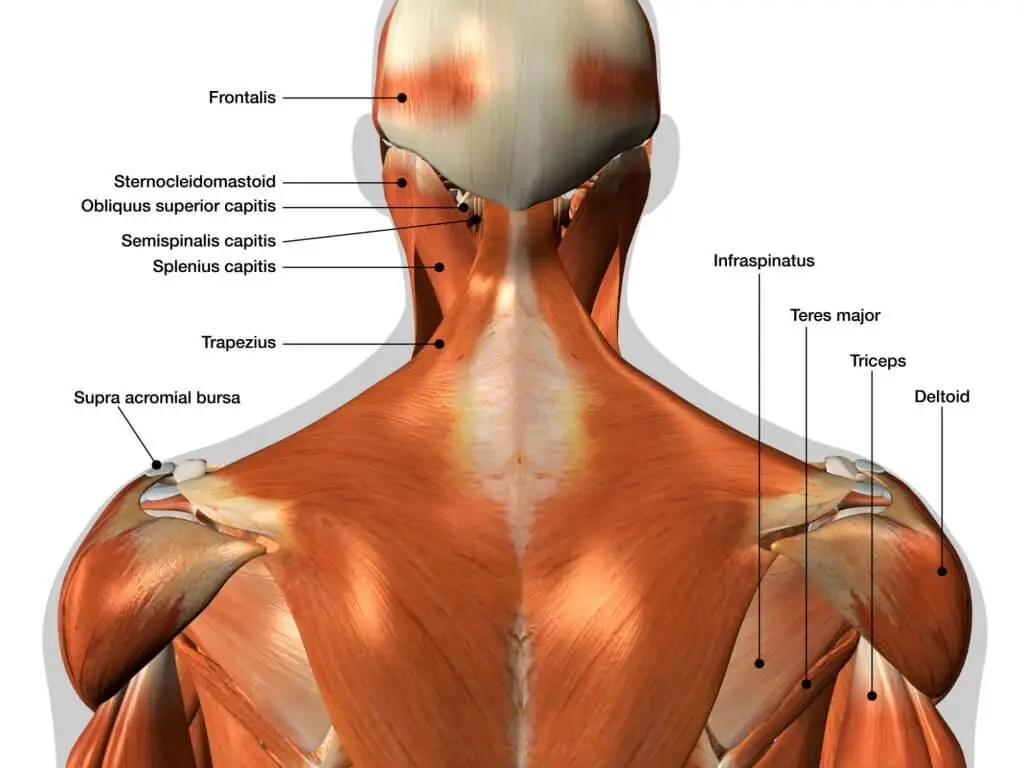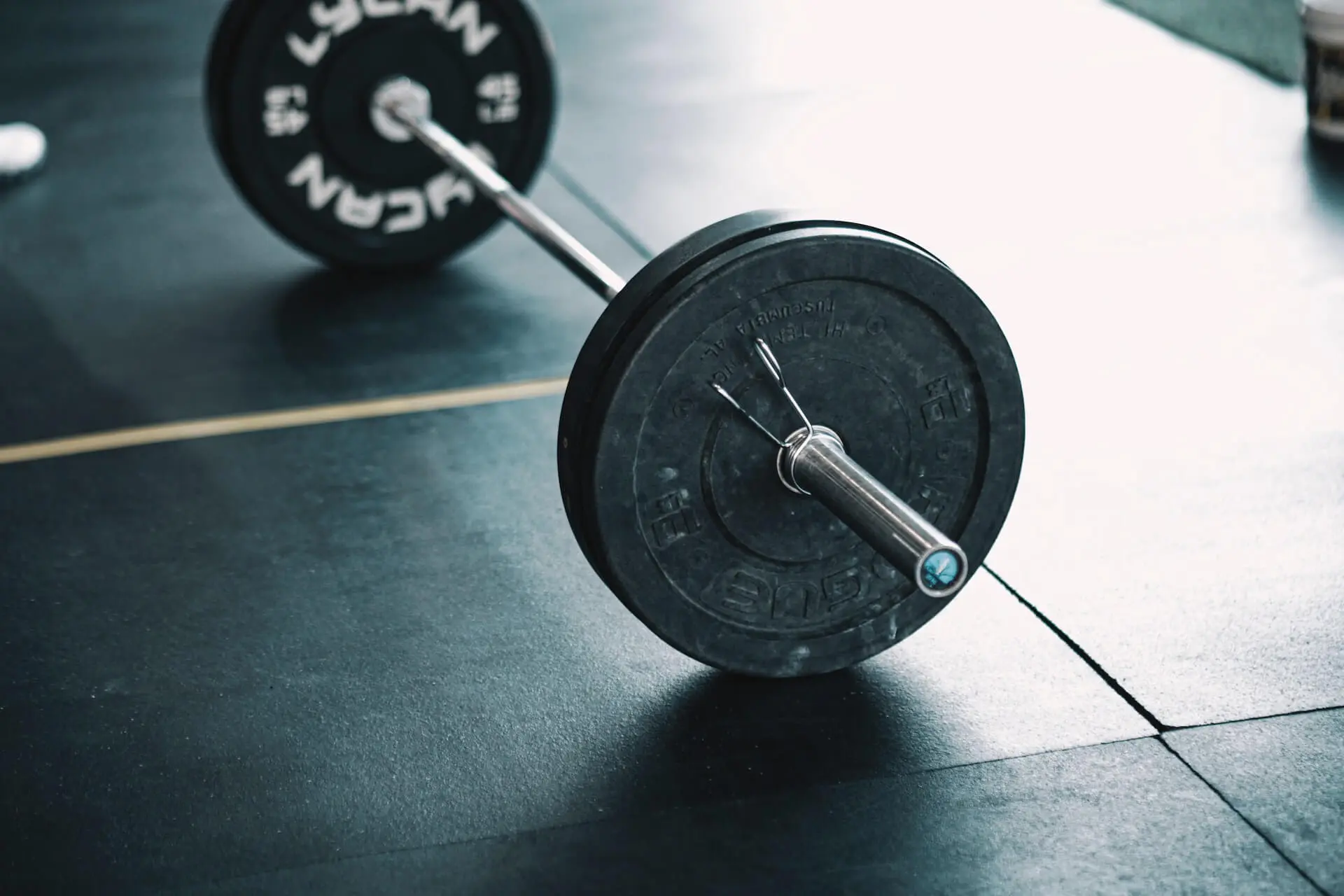Wanting to improve your back strength and mix up your regular workout routine? The barbell row is essential to any CrossFit regimen, but you must have the proper barbell row form to succeed. Otherwise, you could get hurt and be out of the gym for longer than you might like.
Today, we wanted to discuss how to position your body and achieve the perfect form with your rows. Let’s take a look!
Jump to:
- What Is a Barbell Row?
- Why Are Barbell Rows Beneficial?
- Proper Barbell Row Form
- The Muscles You Work When Doing Barbell Rows
- Bonus Tips for Correct Barbell Row Form
- Frequent Mistakes That Could Cause Injury
- Barbell Row Variations
- FAQs
- Why don’t I feel rows in my back?
- Should you lift your heels when rowing?
- How do you engage lats in a barbell row?
- How many reps should I do as a beginner?
- How much weight should I add to my barbell as a beginner?
- How does a barbell row differ from using a row machine?
- Are Barbell Rows Worth It?
What Is a Barbell Row?
A traditional barbell row is a compound exercise that uses your entire body. That’s what makes it so popular. You achieve this movement by lifting a barbell from the ground to your hips using a row motion while bending over. It’s often called a bent-over barbell row because you hinge downward from the hips as far as possible while keeping your back straight.
Why Are Barbell Rows Beneficial?
There are many reasons to love a good barbell row. For starters, they’re relatively easy to do without a lot of equipment. You can even use the same technique with dumbells if you don’t have barbells handy, making them even more accessible. Barbell rows are also safer and easier to master than some other compound, full-body exercises like power cleans.
The potential for building upper body strength with this exercise is also powerful. If you need upper back strength, it’s an excellent way to achieve it with just a few sets per week.
Ultimately, this fundamental exercise improves your body’s trunk strength, meaning fewer injuries and better posture. It also helps your hip hinge movement, increasing flexibility and strengthening your hips. Many exercises, including cardio, are hard on your hips, so maintaining that hinge reduces injury risk.
Proper Barbell Row Form
If you want the benefits of barbell rows, you must do them correctly. Proper form is essential for building muscles without risking injuries. It’s all about getting into the correct position, using the appropriate weight, focusing on angles, and working within your body’s range of motion. We’ve got a few valuable tips to help you.
Proper Feet Positioning

Plant your base with sound foot placement. As a general rule, you’ll want to stand with your feet shoulder-width apart. But if you’re tall, you might benefit from placing your feet slightly wider than your shoulders.
Many people find that angling their feet out slightly makes the movement more manageable, but it’s okay for your foot to angle straight ahead if that’s more comfortable. Keep your feet flat, distributing your weight evenly, and don’t rock onto the balls of your feet.
The bar should center over your feet while on the ground. When looking down, you should see the bar resting mid – foot, meaning you can see your toes on the other side of the bar.
Hand Grip Placement
For the basic barbell row, place your hands at the same width as the outside of your knees. This placement gives you maximum control of the bar and will better target muscles in your upper back and shoulders.
You might adjust your grip slightly depending on your training goals. A narrow grip will work different muscles than a wide grip. For example, placing your hands on the insides of your knees can better prioritize your lat development as long as you keep your body aligned properly.
The conventional barbell row uses an overhand grip, but you could try an underhand grip for a different variation. With an underhand grip, you can bring your elbows closer to your sides, which better engages your bicep muscles and lats.
It’s okay to play around a little with your grip but be warned that a grip that’s too narrow makes it challenging to keep your forearms aligned. A wider grip can cause your elbows to flare. In either case, it increases your risk of injuries.
Body Alignment
Achieving proper alignment in a bent-over barbell row is all about angles. You must keep your back in a neutral position to support your spine and torso while you pull.
Begin the movement by performing a simple deadlift, bringing the bar from the ground to rest at the end of your straightened arms. As you position the bar in a starting position, bend the knees a little to push the hips backward. Your body should bend at the hips at a 15 to 45-degree angle depending on your flexibility.
Stop when you feel it in your hamstrings. If you stretch farther than the flexibility of your hamstrings allows, your back will start to arch. It’s okay to start at a larger angle relative to your hips and decrease as you get stronger. Once you’re in this position, you can begin rowing, pulling the barbell to your torso for as many reps as you feel comfortable with. Rest between sets and assume the proper form again before starting to row.
Precautions for Your Lower Back
The most important thing is to keep your back neutral, or you risk lower back strain. People commonly bend lower than their hamstrings allow, arching their back and putting excess strain on it. A similar issue may occur if you have too much weight on your bar.
Listen to your body. While you might feel your muscles activating in your lower back, it shouldn’t feel like they’re straining. If you feel like you’re losing control during a bent-over row, stop immediately and regroup. This is the best advice we can offer to help you avoid getting hurt.
The Muscles You Work When Doing Barbell Rows

A bent-over barbell row is one of the best muscle builders for your back and shoulders. This is an excellent strength training exercise if you’re seeking core strength. Let’s check out some of the muscles you’ll target with this workout and why you want to strengthen them.
Rhomboids
Rhomboids run from your upper spine to your shoulder blades. Many people with chronic back pain and shoulder impingement suffer from weak rhomboids. Therefore, strengthening these muscles can save you pain and suffering later on.
Trapezius
Your trapezius muscles–also called traps–give you mobility in your neck, arms, shoulders, and torso. You have upper, middle, and lower traps, and rows focus primarily on your middle and lower traps. They help stabilize your spine, reducing your risk of injury in any workout. Stronger traps also help to prevent lower back pain.
Latissimus Dorsi
The primary muscles in your upper back are called latissimus dorsi, or lats. These V-shaped muscles attach your arms to your spine. They offer core stability and a stronger back that’s less prone to injury. Your lats are a vital part of your body’s core strength, helping with everything from breathing deeply to doing pull-ups.
Spinal Erectors
Erector spinae muscles help with posture, keeping your spine in an upright neutral position. They also help with moving side-to-side at the trunk. Those who live a sedentary lifestyle are most likely to experience spinal erector tightness and pain because the erectors make up for weak abs, glutes, and lats. Strengthening these muscles through movements like barbell rows can prevent or reduce this back tightness.
Posterior Deltoids
Most call these your rear deltoids or rear delts, which are responsible for backward arm movements. These enable you to complete pulling motions, such as a row. They also help to stabilize your shoulder joint, and weak delts make it easier for you to experience shoulder injuries. It also causes your shoulders to hunch forward, which causes back pain and can lead to long-term hunched posture.
Brachialis
Strengthening your brachialis or elbow flexors makes every strength training exercise easier. Your elbow flexors enable you to lift without overextending your arm muscles.
Biceps
Your bicep muscles will undoubtedly strengthen from barbell rows. For many people, their biceps are their strongest arm muscles, so it may be tempting to increase your weights to give your biceps a better workout. But remember that too much weight will strain your back and shoulder muscles, so take it easy to start.
Teres Minor
Your shoulder’s rotator cuff relies on several muscles to stabilize the joint, including the teres minor. It runs from your neck to your shoulder joint along the top of your shoulder. Strengthening this muscle reduces your risk of shoulder injuries.
Bonus Tips for Correct Barbell Row Form
Now that we’ve covered the basics of good form for a bent-over barbell row let’s discuss a few bonus tips.
Once again, don’t skip checking your form when setting up your row. Make sure the bar rests above mid – foot and that you’re spreading your strength evenly across both feet. Focus on engaging muscles in your torso and hinge from the hips. Refrain from using your back to bend forward. It’s okay if you have a bigger angle when starting out. With time and repetitions, the angle will naturally decrease.
When you pull the bar toward you, aim for your hips, pulling the bar toward your belly button. Your elbows should be at a 45-degree angle as you pull backward and at a 90-degree angle when lowering the bar. As you pull back, feel the squeeze in your lats as your shoulder blades naturally pull together.
Most importantly, listen to your body. You should feel your muscles activate, but you shouldn’t be in pain. If it hurts, stop, readjust, and try again. You might have to drop weight if you can’t complete a row without keeping your body in proper alignment.
Frequent Mistakes That Could Cause Injury
Doing a barbell row properly should increase your range of motion and help to prevent future injury. Failing to do it properly can mean getting hurt. So let’s look at some common mistakes that might cause injury.
Erratic Movements
You should feel in control of the movement at all times. If your elbows flare, your back caves, or you jerk the bar to your torso, you’re flirting with danger.
Return to the proper starting position and focus on controlling the movement. Shift your lifting power evenly from your feet to your back to your shoulders, and consider lighter weights to help you control the motion.
Body Out of Alignment
Lifting with a misaligned body is the quickest way to get hurt. If your feet are too close together, your back muscles could overcompensate. If your grip is too wide, your elbows can flare erratically.
Take a few seconds before you begin each set to check your body. Is your torso at the right angle relative to your hips? How are your feet? Is your grip correct? Are you using too heavy weights? Analyzing the proper form for your barbell rows will protect you in the long run.
Swooping Back
One of the most common mistakes is letting your back arch or cave in. If your back is too arched, you might be bending too low for your hamstrings’ flexibility to allow. If your lower back caves in, you’re probably not hinging properly from the hips. It’s always better to start with your body at a bigger angle relative to your hip hinge to protect your back and work your way down over time.
Moving Your Neck and Wrists with the Lift
Your neck should always remain in line with your straight back. Don’t let it strain or dip while you lift. Your wrists should not bend as you pull to protect the wrist joint. Neck and wrist movement while lifting heavy weights increases strain on these muscles and most commonly leads to overuse injuries like tendonitis.
Loose Elbows
Keep your elbows tight relative to your body as you perform your barbell rows. A traditional row involves keeping your wrists close to your body and moving them backward at a 45-degree angle.
If you widen your grip, your elbows will be farther away from your body, and it’s much easier for them to flare out of control. Don’t let them wander to prevent overuse injuries of your elbow flexors.
Bumping Knees
Watch your knees as you bring the bar up and down. This goes without saying, but hitting your knees with the heavy bar will hurt! More importantly, if you’re hitting your knees, it means something is misaligned.
Too Much Weight
Don’t be ashamed of using lighter weights. Often, body misalignment or straining is a sign that you’re using too much weight. So feel free to drop weights in the name of proper form.
Barbell Row Variations
If you want to focus on strengthening specific muscles, consider trying a few barbell row variations. Here are a few we recommend.
T-Bar Rows
T-bar rows isolate your lats and upper back, increasing muscle thickness and maturity. You perform a T-bar row by straddling the bar and using a T-bar attachment, such as a handle, to lift just one end of the bar to your torso while the other remains on the ground. Gripping the T-bar, you’ll perform the rows in the same manner as conventional barbell rows, but you’ll have a more narrow grip that isolates those upper back muscles.
Pendlay Rows
The Pendlay row, named after Olympic weightlifting coach Glenn Pendlay, is a more advanced move for those who’ve mastered a regular barbell row. You must have adequate hamstring flexibility to reach a 90-degree angle for this movement.
You perform this exercise by settling your feet shoulder-width apart and resting the bar above your mid – foot. Bend forward at a flat 90-degree angle, reach down, and pull the bar to your torso in a row motion.
Again, please note that this is an advanced move you should only attempt if you can hinge from the hips and maintain a flat back at a 90-degree angle.
Inverted Rows
Inverted rows are great for upper torso and grip strength. They’re reminiscent of a backward push-up in which you rest the bar on a power rack and lie below it. Grip the bar at shoulder-width and pull your body up, keeping your back and legs straight.
Many people performing this compound exercise like to cross their legs, but you can also perform it with your feet side by side and close together. Your feet should rest on the heels as you lift your body.
FAQs
Let’s check out a few frequently asked questions to help you perform your barbell rows at maximum safety and effectiveness.
Why don’t I feel rows in my back?
If you don’t feel rows in your back, you could be subconsciously relying on your biceps instead of your back muscles. This usually manifests as pulling your arm back farther than necessary.
The solution is lightly gripping the barbell as if your hand is a hook. Then, use your elbows rather than your biceps to pull the bar toward you. Your shoulder blades should naturally retract, and you should feel the back muscles activate.
Should you lift your heels when rowing?
No. Focus on spreading the weight evenly through your feet. If anything, lean more on your heels than the balls of your feet to increase stability.
How do you engage lats in a barbell row?
Proper form will engage your lats, so check your form and ensure you’re pulling with your elbows rather than your bicep.
But if you’re not feeling it even with perfect body alignment, you might need to increase your weight slightly or deepen your bend.
How many reps should I do as a beginner?
A general rule for all lifts is to start with 8-15 reps and see how you feel. As you master the exercise, you might consider increasing the reps slightly. But remember that sometimes it’s better to increase the weight and do fewer reps than it is to do more reps with a lighter weight.
It just depends on the goals you have. Higher reps and lighter weight mean greater muscle endurance, while more weight and fewer reps mean bigger muscle size and strength.
How much weight should I add to my barbell as a beginner?
The amount of weight you use will depend on the person. A smaller person with low muscle stamina might start with just a standard bar that weighs 45 pounds with no additional weight. But a larger person in better physical shape might start with 100 pounds or more.
The best advice we can give is to start low and add weights as you go. If you’re not feeling your muscles engage when you’re using perfect form, you might need more weight. It’s always better to start low and add on than it is to start high and hurt yourself.
How does a barbell row differ from using a row machine?
Barbell rows can often increase muscle strength and thickness more effectively than row machines. A row machine is great for stamina and cardio, but opt for the barbell during your gym workouts if you’re building strength.
Are Barbell Rows Worth It?
Barbell rows are a great addition to your functional fitness routine if you’re seeking stronger back, shoulder, and arm strength. They’re flexible and accessible if you get your form right from the start. We highly recommend adding barbell rows to your CrossFit routine.
What do you think? Are barbell rows worth adding to your program?















